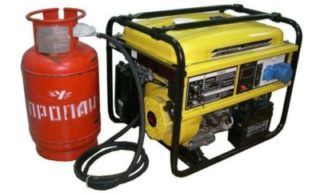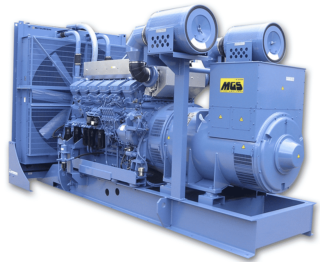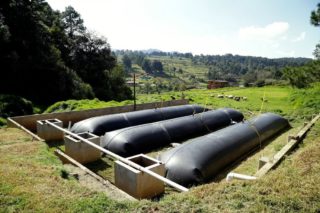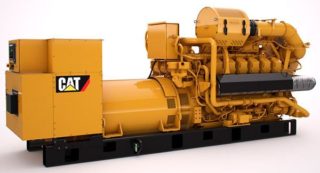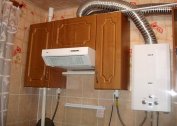In the absence of a centralized power supply, alternative energy sources are used. In this case, a gas generator is often used for electricity, which is installed in private houses, in summer cottages. Such a source can be the main or backup, in case of interruptions in the centralized network. Before choosing a product, you should understand its characteristics and features.
The device and principle of operation of the gas generator for electricity
A gas generator for the home is often used for heating. Its device is no different from similar models operating on other types of fuel. In its composition there are such parts:
- Body. It is rectangular or cylindrical. It is usually made of sheet steel.
- The combustion chamber. Since the device runs on gas, it does not require a tank for loading fuel. This assembly is made of heat resistant steel.
- Compressor. It is needed to pump air into the furnace. Without this, the fuel will not ignite.
- Turbine. Heated and expanded air enters it.
There is no fuel tank in the unit, since it runs on liquefied or natural gas. Instead, a combustion chamber is installed. The principle of the apparatus is simple. First, air enters the compressor, is compressed and sent to the combustion chamber, where it is mixed with a small amount of fuel. The mixture lights up and is brought to a high temperature. Gas enters the turbine and makes it rotate, generate electricity. Part of it is spent on the operation of the domestic gas generator itself. The combustion products are discharged through the exhaust pipe.
Main characteristics
When choosing a specific model of the device, its tasks and technical characteristics are taken into account.
Power
How many devices a gas generating station can supply depends on the power of the unit. The indicator ranges from 2-500 kW.
The main groups of devices:
- Up to 10 kW. Installed as a backup source of electricity in the country or in a private house. You can connect a refrigerator, lighting, air conditioning to it. Sometimes you can start the washing machine or microwave.
- From 10 to 25 kW. Such gas electricity generators are used to autonomously provide country houses and cottages. They allow you to connect all household appliances with a high starting coefficient.
- More than 25 kW. They are installed for power supply of several houses, a construction project, and a production workshop.
To ensure uninterrupted power for all household equipment, it is necessary to summarize the power of all devices connected to the network. In addition to the obtained value, 20-30% of the stock is added.
Cooling system
The gas generator for electricity works properly, if it does not overheat. To prevent problems, several types of cooling systems are used: air and water. The first option is natural (suitable for open devices with minimal power) and forced. The engine and generator are blown in from different directions.
Water cooling is suitable for powerful devices (from 20 kW) in industrial plants. It normalizes the temperature of the generator and allows you to use it for heating or hot water supply.In operation, the system practically does not make noise.
Duration of work
By the duration of the work, the following devices are distinguished:
- Continuous action. This is an autonomous installation that fully provides household appliances with electricity. Without a break, such a unit is able to work up to 20 hours. It is equipped with an automatic control system (on-off), as well as water cooling. Periodically, the device is stopped to change the oil.
- Periodic power supply. The devices are installed in summer cottages or industrial workshops with a variable work schedule. The maximum working time is 12 hours. Since the device is equipped with an air cooling system, a longer period of operation is not possible.
- Emergency start. Not used for permanent supply of electricity to the house. Such devices are needed if the power in the main network is turned off for a while.
For domestic use, all types of devices can be used. It takes into account what functions the unit should perform.
Fuel type
Gas generators are operating. If there is no central highway, it is allowed to use cylinders with a liquefied type of fuel. If available, the connection requires permission from utilities. The pressure in the network in this case corresponds to 1.3-2.5 kPa. Instead of the classic fuel option, butane, propane, biogas can be used. The pressure when using liquefied fuel is 2-6 kPa.
The sizes of gas generators depend on their power. Minimum values: 2m * 1m * 1m, maximum - 5m * 2m * 2m.
Criterias of choice
To choose the right gas power station for a private house, you need to consider its power. High performance is required for devices that operate continuously, providing electricity and heating. For periodic use, low-power devices are suitable. The following criteria are also taken into account:
- number of phases;
- start type: automatic or manual;
- execution option and dimensions;
- fuel consumption and type of food (from the highway or cylinder);
- Placement
If the device will be installed in a separate room, you can use a simple frame design. For outdoor installation, an aggregate in a protected enclosure is required.
Scope of application
Electric gas generators are used in everyday life and industry. They are installed if the backbone network is operating irrationally. You can install the unit at a high cost of electricity. It is mounted near new buildings that are not yet connected to the central network.
In hospitals or in enterprises where a continuous production cycle is important, a backup gas generator is installed to generate electricity, which works if the electricity is turned off in the event of an emergency, repair work.
Installation and Connection
Household gas generators must be connected correctly to the fuel source. This process is not easy, especially when equipping the unit with an autostart system. A base is prepared for the installation of the device: it must be absolutely even. If the generator is installed indoors, it is equipped with ventilation.
If necessary, the room is heated. It is also necessary to provide for the exhaust system to the outside. The minimum area of the room in which the generator is installed is 15 cubic meters. When connecting the device to the central gas highway, permission from the utilities is required. Changes are made to the technical design of the building and a contract is concluded for the maintenance of equipment.
Advantages and disadvantages
Gas generators for the home are convenient in that they use different types of fuel, which are much cheaper than gasoline. They have such advantages:
- the ability to connect to the cylinder and main pipe;
- the use of a device for generating electricity, heating a room, producing hot water;
- durability, since when using gas, the wear of the internal parts of the generator is minimal;
- environmental Safety;
- profitability.
However, there are drawbacks: not everywhere there is a gas supply. When connecting to a trunk, permission from a special service is required.
Despite the costly installation process, the use of gas generating plants is justified in case of frequent power outages or its complete absence. If it is impossible to use the main fuel system, cylinders can be used.
When choosing a device, the conditions for its use are taken into account, as well as the tasks that the unit must solve.
